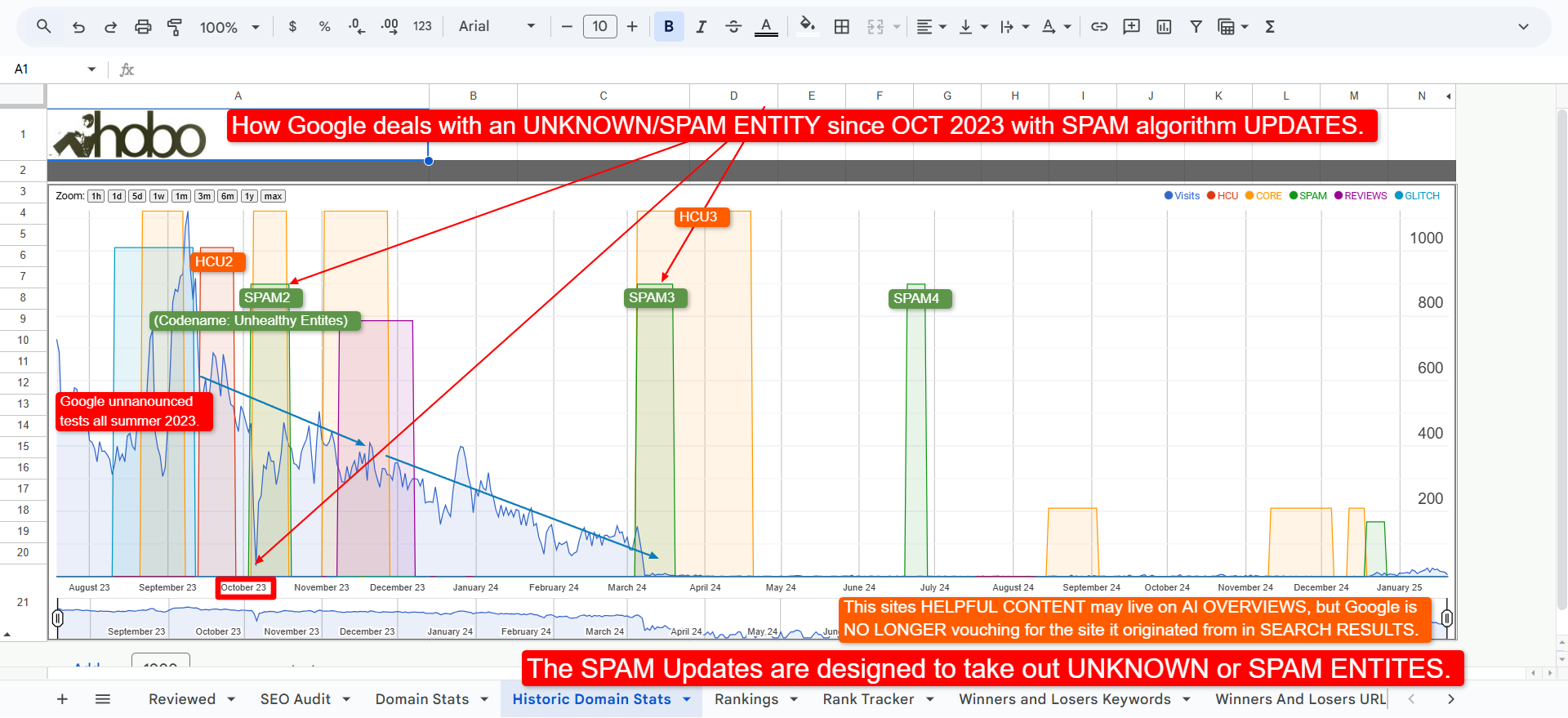Get a full EEAT based SEO audit for your website
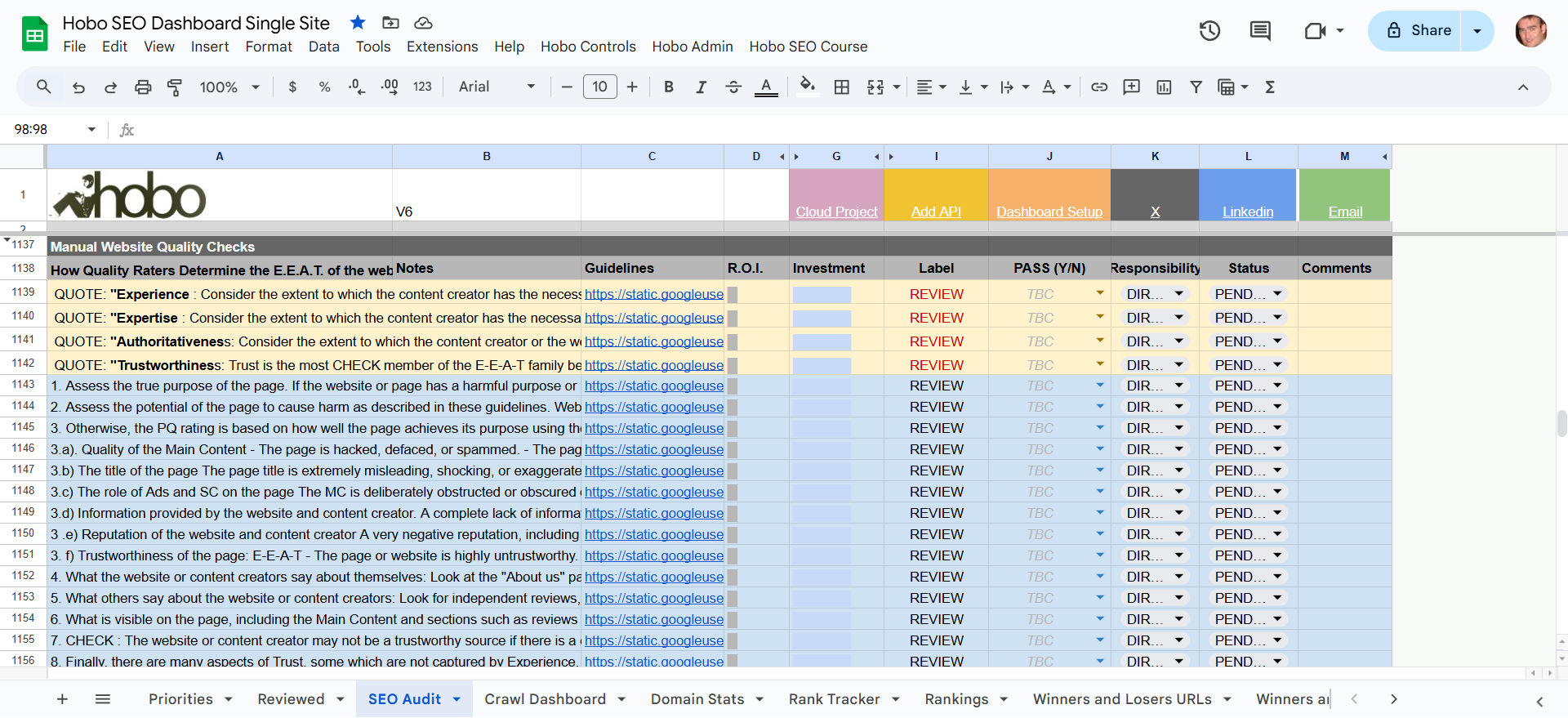 Let’s get straight to it.
Let’s get straight to it.
You’re here because your website’s traffic is likely unpredictable, or trending down, and you’re trying to make sense of the constant barrage of Google algorithm updates.
You’ve probably heard a dozen different theories about what Google wants, from technical minutiae to vague advice about “writing good content.”
For over two decades, my work has been about cutting through that noise and focusing on the one thing that has remained constant: Google’s mission to reward quality and trustworthiness at the top of their organic results.
The Hobo E-E-A-T Review of Your Website is an ad-hoc review of the current state of your E-E-A-T carried out by me over a period of working days. This includes a full SEO audit, as both cannot really exist in isolation in modern SEO (page experience, for instance, is a foundational aspect of both E-E-A-T in the QRG (Quality Rater Guidelines – which is more user focused – and in the official Google Webmaster Guidelines, which is more technically focused).
When I work with your business, I don’t just leave you to work it out yourself. I also provide my full suite of bespoke tools for you to track SEO performance over the coming year.
“GWP has worked with Hobo Web for around 8 years, and in that time the performance of the site has gone from strength to strength – considerably outstripping expectations. Hobo has provided timely, considered and expert advice which has always proved beneficial, and have also been proactive in suggesting new tactics and strategies to try. All communication is friendly, and their level of service is spot on. Hobo Web is thoroughly recommended to anyone looking for SEO advice/services, and website performance improvements.” Matt Dobson | Marketing Manager GWP Group 2025.
Why Trust Is the Foundation of Successful SEO
To understand where Google is going, you have to understand where it’s been.
The current focus on E-E-A-T (Experience, Expertise, Authoritativeness, and Trustworthiness) isn’t a new fad; it’s the culmination of a war on low-quality, untrustworthy content that began more than a decade ago.
Beyond Keywords and Backlinks
The core of your traffic instability isn’t about a single keyword you failed to optimise, or a link you failed to build a meta description you neglected to add or.
It’s about a fundamental misalignment with Google’s long-term mission.
As far back as 2011, Google’s Matt Cutts was clear about their objective: “We actually came up with a classifier to say, okay, IRS or Wikipedia or New York Times is over on this side, and the low-quality sites are over on this side”.
This has always been the game: sorting the web into legitimate, authoritative entities and a sea of low-quality, anonymous pages.
Even earlier, in 2008, Google’s Eric Schmidt identified the solution to the “cesspool” of low-quality search results: “Brands are the solution, not the problem. Brands are how you sort out the cesspool”.
This concept of “brand” isn’t just for multinational corporations.
As Google’s Danny Sullivan clarified in 2024, in the context of modern SEO, “YOUR small site is a brand, YOU are a brand”.
A brand, in Google’s eyes, is simply a verifiable, accountable entity that stands behind its content.
This is the foundation of trust, and it’s what we’re going to build. The perceived chaos of recent algorithm updates is not chaos at all; it’s a convergence.
Google is consolidating over a decade of quality-focused initiatives into a single, powerful, and continuously running core ranking system.
From Panda to the “Always-On” Helpful Content Core Updates
The journey to today’s E-E-A-T-centric algorithm is a clear, logical progression.
- Google Panda (2011): This was the first major shot across the bow that hit the headlines. It wasn’t about individual pages but the site as a whole. As Google stated in 2016, “Panda is an algorithm that’s applied to sites overall and has become one of our core ranking signals. It measures the quality of a site“. It targeted thin, low-value content.
- Penguin (2012): This update targeted manipulative link schemes, another attempt to separate genuine authority from artificial signals.
- Helpful Content Update (HCU) & Core Integration (2022-2024): This is the most critical evolution for you to understand. Initially, the Helpful Content system was a separate signal targeting content “created primarily for search engines, not for humans”. However, as of the March 2024 Core Update, this is no longer a separate system. It has been absorbed into the main core ranking algorithm.
This integration is a game-changer.
It means there is no longer a distinct “Helpful Content penalty” to recover from. Instead, “helpfulness” as measured by proxies for E-E-A-T is now a fundamental, persistent part of how Google evaluates your site every single day.
The system is always learning. As Google confirmed in 2024, “The classifier is always running. If it sees a site has reduced unhelpful content, the site might start performing better at any time”.
This makes recovery possible but requires a fundamental and ongoing commitment to quality and especially trustworthiness, not a one-time fix.
The March 2024 update, which promised to reduce low-quality, unoriginal content by 40-45%, demonstrates the massive scale of this initiative.
Why the Quality Rater Guidelines (QRG) Are Your Guide
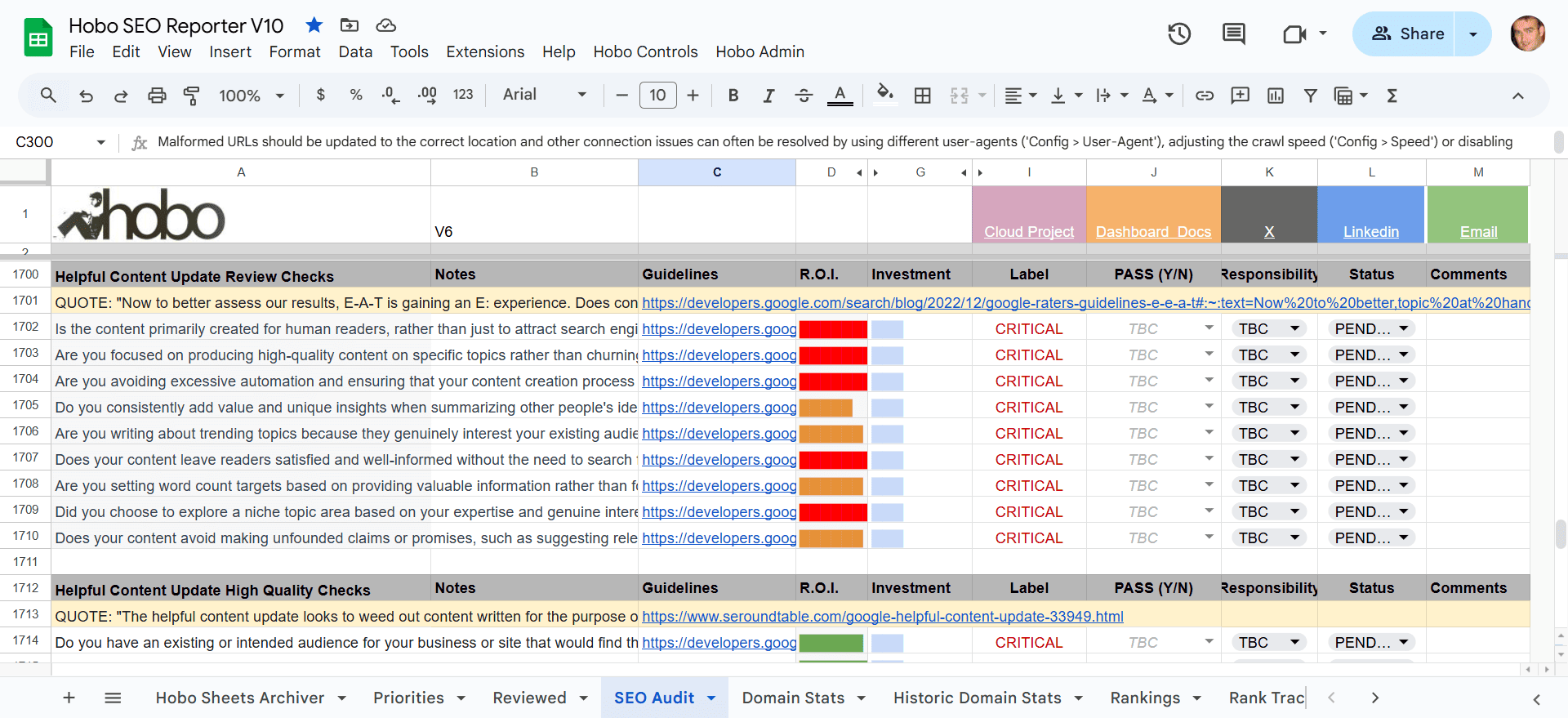
My entire methodology, and the logic behind my tools, is based on one primary source: Google’s Search Quality Rater Guidelines (QRG).
This is the 170+ page document that instructs Google’s 16,000 human raters on how to assess website quality.
Their feedback is then used to evaluate, train and refine the ranking algorithms. It is the closest thing we have to an instruction manual for what Google values.
For our review, we are well-versed in and use both the (leaked) 2014 and the latest 2025 versions of the QRG.
This allows us to see both the foundational principles that have remained unchanged for a decade and the recent evolutions, like the addition of “Experience.”
The importance of these concepts is not new.
A 2017 version of the guidelines stated bluntly, “Important: Lacking appropriate EAT is sufficient reason to give a page a LOW QUALITY rating”.
This was true then, and it’s even more critical today.
Lowest quality to Google = SPAM.
Deconstructing E-E-A-T: The Four Pillars of a Trustworthy Website
Now, let’s break down the framework that the QRG uses to define quality: E-E-A-T. Understanding each component is essential, but it’s even more important to understand how they fit together and which one holds the most weight.
E-E-A-T is Not a Ranking Factor; It’s the Target
Let’s clear up the biggest misconception in SEO right now. E-E-A-T is not a direct ranking factor like page speed, nor is it a single score your site receives.
Google’s Danny Sullivan has repeatedly tried to clarify this. Instead, E-E-A-T is the concept that Google’s algorithms are trying to reward. As Google stated in 2025, “E-E-A-T itself isn’t a specific ranking factor…it is a “a mix of factors” with ‘TRUST.. most important’.
Our job as SEOs and website owners is not to “optimise for E-E-A-T.” Our job is to build and demonstrate the real-world signals that Google’s “mix of factors” can measure as proxies for Experience, Expertise, Authoritativeness, and, above all, Trust.
Experience (The First E): The Antidote to Unhelpful AI Content
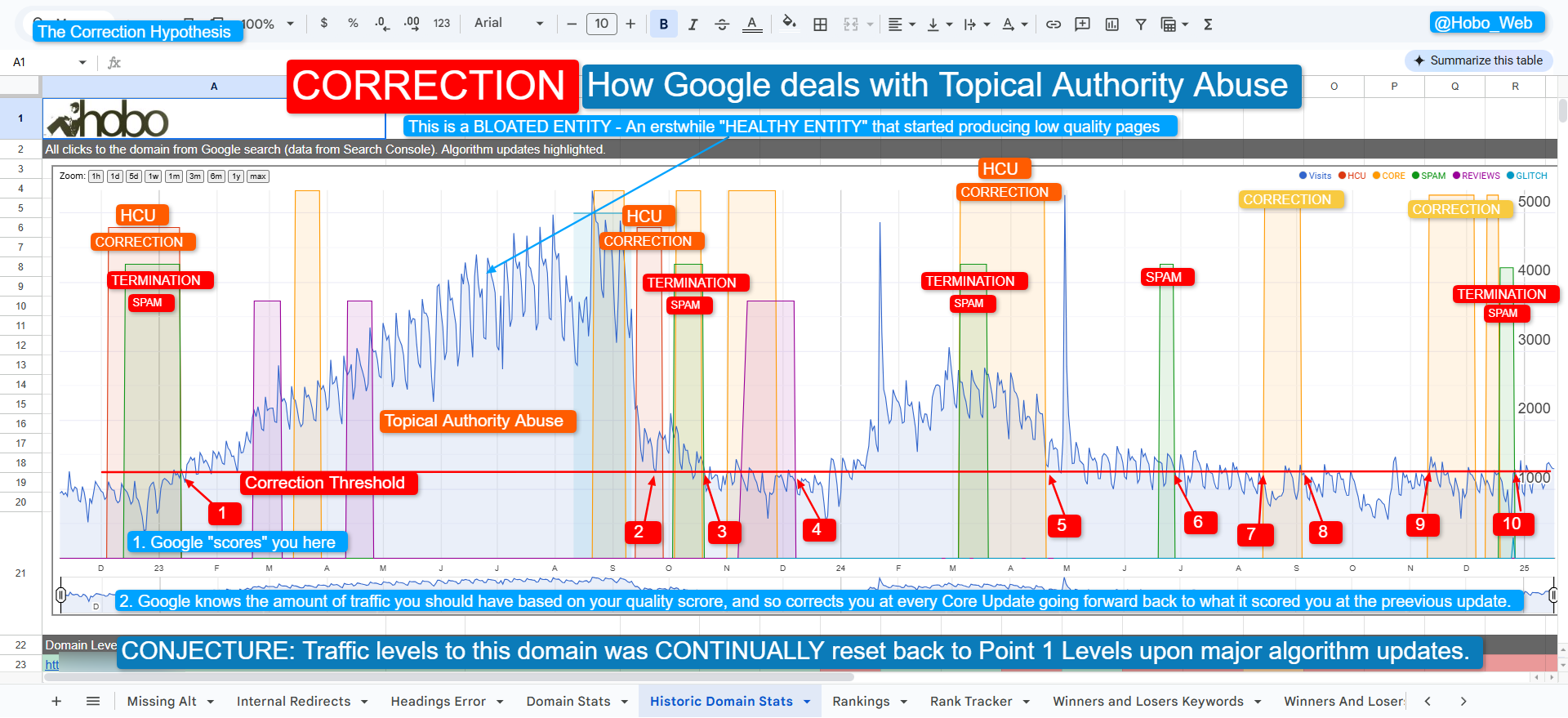
The “E” for Experience was added to the QRG guidelines in December 2022.
This was not a random addition. It was a direct, strategic response to the explosion of generative AI, which excels at summarising existing information but has no actual experience.
- What it means: Demonstrating that the content creator has first-hand, real-world involvement with the subject. It’s the difference between a review of a product you’ve only read about and a review of a product you’ve actually used.
- How to demonstrate it: This is about showing, not just telling. Use original photos and videos of you using a product or visiting a location. Write in the first person, sharing personal anecdotes and unique insights. This is Experience in action.
As Google’s John Mueller warned, “You can’t sprinkle some EXPERIENCES on your web pages. It’s like that doesn’t make any sense” It must be authentic and woven into the fabric of your content.
Google’s 2025 guidelines make a clear distinction: “Some content might be helpful based on the experience it demonstrates, while other content might be helpful because of the expertise it shares”. For many topics, especially reviews and tutorials, demonstrating experience is now paramount.
Expertise (The Second E): Proving You Know Your Stuff
Expertise is about having the necessary knowledge and skills in a particular field. For “Your Money or Your Life” (YMYL) topics—like medical, legal, or financial advice—this is critical and often requires formal credentials.
- How to demonstrate it: This is where you prove your qualifications. Create detailed author biographies that list credentials, education, professional background, and relevant publications. When making claims, especially on YMYL topics, cite reputable, authoritative sources like scientific studies or government publications. Above all, ensure your content is factually accurate; the QRG explicitly states that factually inaccurate content is a hallmark of low quality.
Google is actively looking for the true source of expertise. As Danny Sullivan put it when describing a potential problem, “I’m a local mechanic, so I’m going to write 25 different things, and I’m an expert local mechanic to do it. Except the mechanic didn’t write it”.
This perfectly illustrates the disconnect Google is trying to identify. The expertise must belong to the actual creator of the content.
The long-standing guidance from the 2014 QRG remains true: “Providing.. background information is particularly important for medical, financial, or other topics for which expertise is needed”.
Do remember, however, that EEAT up until 2018 was “mostly a links thing”. That means high-quality links (and mentions) on authoritative sites are still gold to your business and a real entity identifier in Google’s ranking systems.
Authoritativeness (The A): What Do Others Say About You?
Authoritativeness is, in essence, your reputation.
While Experience and Expertise are things you demonstrate on your own site, Authoritativeness is largely determined by what the rest of the web says about you and how users interact with your content.
- How to demonstrate it: This is where traditional off-page SEO signals come into play, but with a focus on quality over quantity.
- Backlinks: Earn links from other well-respected, authoritative websites within your niche. A link from a major industry publication is worth more than a hundred links from low-quality directories.
- Mentions: Even unlinked mentions in reputable news articles or by known experts on social media contribute to your perceived authority.9
- Reputation: What do reviews on third-party sites (like Trustpilot, Yelp, or industry-specific forums) say about your business? Google’s raters are explicitly instructed to look for this information.
The QRG gives a direct instruction to its human raters: “Look for reputation information about the website and/or content creators. What do outside, independent sources say about them?”.
Your goal is to ensure that when they look, they find positive reinforcement of your authority.
Trust (The T): The Most Important Lever
We now arrive at the absolute core of the E-E-A-T framework, the element that underpins all others, and my primary area of specialisation. As Google’s 2025 documentation states unequivocally, “Of these aspects, trust is most important”.
This isn’t just a casual preference; it’s a foundational requirement. A site that is not trusted cannot be considered high-quality, no matter how expert its content may seem. The QRG states: “Untrustworthy pages have low E-E-A-T no matter how Experienced, Expert, or Authoritative they may seem“.
Google’s evaluation process can be seen as a two-step sequence. The first step is a verification check: “Is this a real, legitimate, accountable entity?”
This is the Trust question. If the answer is “no,” the page is flagged as low quality, and the evaluation effectively stops.
Only if the answer is “yes” does Google proceed to the second step: “Is the content from this entity any good?”
This is the assessment of Experience, Expertise, and Authoritativeness.
This is why all the effort you put into creating expert-level content can be completely wasted if you fail the initial trust check.
- How to demonstrate it: Trust is built through transparency and accountability. Here are the non-negotiable signals, drawn directly from the QRG:
- Clear Responsibility: Your ‘About Us’ and ‘Contact Us’ pages are critical trust signals. It must be immediately clear who is behind the website.13 The QRG asks:
“Every page belongs to a website, and it should be clear: Who… is responsible for the website.”. - Accessible Contact Information: Provide multiple, easy-to-find ways for users to contact you. An email address, a phone number, and a physical address are extremely important, especially for e-commerce or YMYL sites.13 The guidelines are explicit:
“Contact information and customer service information are extremely important”. - Secure Website: Using HTTPS is a basic, mandatory signal of a secure and trustworthy site.
- Comprehensive Policies: Your Privacy Policy, Terms of Service, and, for e-commerce sites, shipping and return policies must be easy to find and understand.
- E-commerce Trust: For any site that takes money, building user confidence is paramount. As the QRG notes, “Stores want customers to feel comfortable buying their products online”.
- Honesty and Transparency: Your site must be honest in its purpose. Ads should be clearly labelled and not designed to deceive users into clicking them. The 2014 QRG warns that “Pages with Ads that are designed to look like MC should be considered deceptive” and rated Lowest.
Trust is the ticket to the party. Without it, you’re not even getting in the door.
The Disconnected Entity: The Greatest Risk to Your Website in 2025
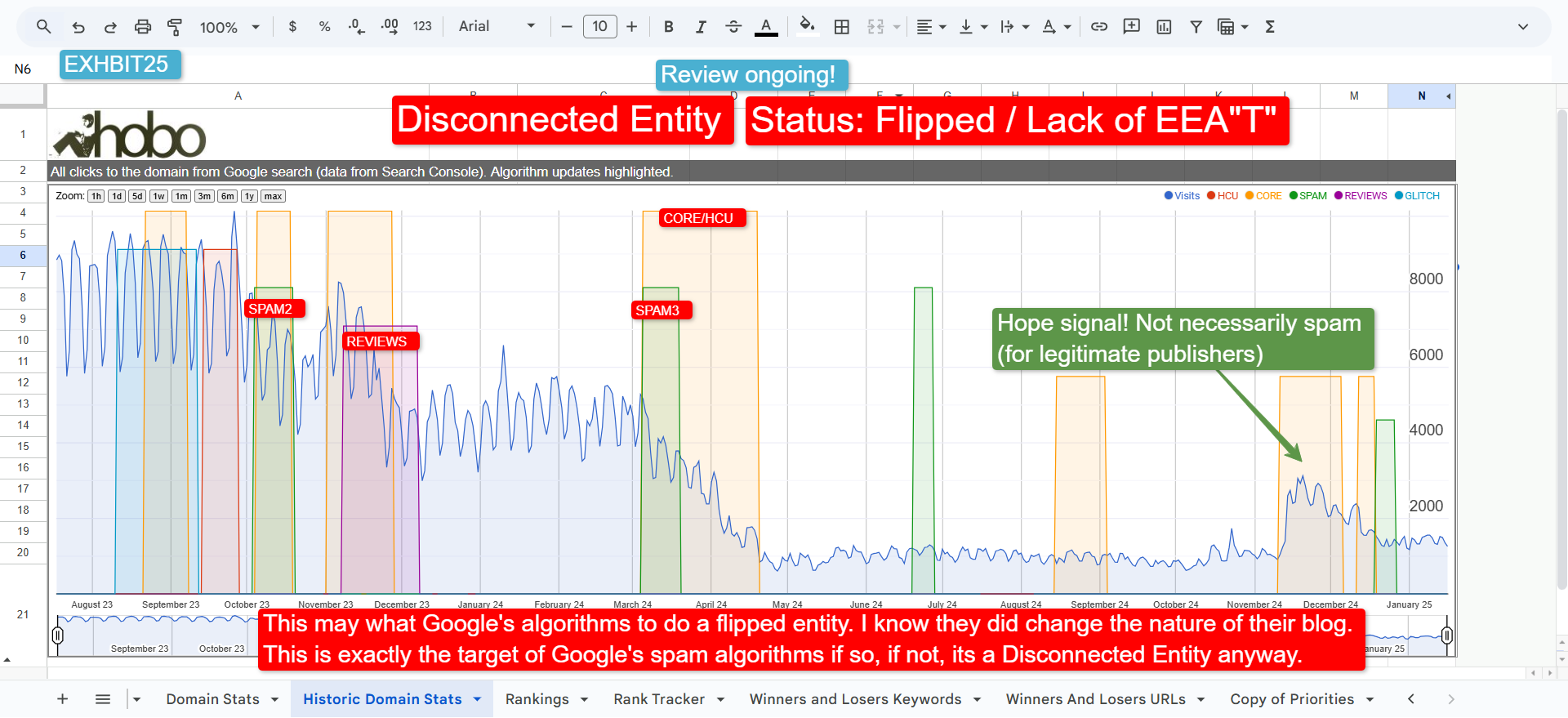
Based on my analysis of hundreds of websites and years of studying Google’s updates, I’ve developed what I call the “Disconnected Entity Hypothesis.”
It’s the single biggest threat to websites (outside of AI overviews, of course) that don’t have their houses in order, and it directly explains why so many sites have seen their traffic decimated by updates like the Google HCU update and the October 2023 Google Spam update.
It’s the sort of site that Google Quality Rater guidelines label as low or lowest quality.
The Core Question: “Who Is Responsible for This Website?”
The entire concept hinges on the primary question that Google’s quality raters are tasked with answering, as laid out in Section 2.5.2 of the QRG: “To understand a website, start by finding out who is responsible for the website and who created the content on the page”
If a rater cannot easily and confidently answer this question, the site is immediately at a disadvantage in this page quality rating exercise.
The 2014 QRG provided a chillingly clear example of the consequence: “Because there is no information about who owns this website and who created this content, we will consider this an untrustworthy website”.
Anonymity is the enemy of trust when it comes to ranking in Google Search in 2025.
The Disconnected Entity Hypothesis Explained

My hypothesis is this: Websites that lack a robust, verifiable, real-world presence are being systematically classified by Google’s algorithms as “unhealthy” or “disconnected entities.”
These sites are then de-prioritised in search results, regardless of the superficial quality of their content.
This isn’t a penalty in the traditional sense; it’s a failure to pass a fundamental trust threshold.
These sites are seen as having no one accountable for their information.
This idea was articulated perfectly years ago in a book by former Google CEO Eric Schmidt: ‘Even the most fascinating content, if tied to an anonymous profile, simply won’t be seen because of its excessively low rank’.
This is no longer a future prediction; it is the current reality of Google’s search ecosystem.
It is the algorithmic fulfilment of Matt Cutts’ 2011 vision of sorting the web into trusted sources and “low-quality sites.”
I have been in the game long enough to remember every one of these quotes making headlines in the SEO community.
The Cost of Anonymity: A Look at the Damage

The consequences of being perceived as a disconnected entity are severe.
Look at the traffic charts presented in this article, taken from our Hobo SEO Dashboard for a site I took on to analyse HCU (The Google Helpful Content Update).
This pattern is a classic symptom of a trust deficit coupled with a strategy focused on “search engine first content”.
The site’s traffic is highly volatile, often seeing brief spikes during the chaos of a core update rollout, only to be suppressed again once the new quality signals fully settle.
This is the life of a site living on the edge of Google’s quality threshold, constantly being re-evaluated and found wanting.
As the caption says, “This is what happens to your Google traffic when Google, for whatever reason, doesn’t trust your site”.
This is the reality for countless small publishers who, as one analysis noted, were “nuked” by the HCU and SPAM updates because they “didn’t differentiate themselves enough from spam”.
They looked like disconnected entities to me in many cases. In short, that means, if I used the Google Quality Rater guides to review this site as a human evaluator, the site would fail fundamental requirements in the QRG.
Google’s own Danny Sullivan has been blunt about this, stating in 2024 that for the “fly-by-night niche type of thing – sorry, probably NOT going to want to try to do a better job for YOU”.
Google is actively choosing not to reward sites that it cannot verify and trust.
In fact, it is “taking them out”.
Table 1: The QRG “Lowest Quality” Infraction Checklist
To make this tangible, I’ve compiled a checklist of actions and characteristics that Google’s own 2014 Quality Rater Guidelines explicitly defined as “Lowest Quality.”
I’ve mapped each infraction to the modern E-E-A-T principle it violates.
Use this as a diagnostic tool to see if your site is inadvertently sending these powerful negative signals.
| Lowest Quality Infraction (Direct Quote from 2014 QRG) | Corresponding E-E-A-T Principle Violated (2025 Framework) |
| “Websites and pages which are created to…only make money with no attempt to help users” | Trust (Purpose is deceptive and not user-first) |
| “There is no information about who created or is responsible for this content. There is no evidence of E-A-T” | Trust, Expertise (Anonymity, lack of accountability) |
| “YMYL pages with absolutely no website information… should be rated Lowest.” | Trust (Extreme lack of accountability on a sensitive topic) |
| “This page has no purpose and no reason to exist.” | Trust (Lack of purpose, no value provided) |
| “Content which is copied, but changed slightly from the original.” | Expertise, Trust (Lack of effort, unoriginal, plagiarism) |
| “If very little or no time, effort, expertise, or talent/skill has gone into creating the MC, use the Lowest quality rating.” | Experience, Expertise (Lack of human effort and skill) |
| “The answers are poorly worded and have incorrect and potentially dangerous medical advice, making it the lowest quality MC” | Expertise, Trust (Harmful, inaccurate information) |
| “Pages with Ads that are designed to look like MC should be considered deceptive” | Trust (Deceptive design, manipulates users) |
| “This page was created to make money from clicks on Ads rather than to help users.” | Trust (Purpose is purely commercial, not helpful) |
| “Important: Negative reputation is sufficient reason to give a page a Low quality rating.” | Authoritativeness, Trust (External signals indicate untrustworthiness) |
| “An unmaintained site… should be rated Lowest.” | Trust (Neglect signals the site is abandoned and unreliable) |
| “Pages which appear highly untrustworthy should be rated Lowest, even if you’re not able to completely confirm their lack of trustworthiness.” | Trust (The overall impression is one of untrustworthiness) |
My Diagnostic Toolkit: How I Conduct an E-E-A-T and Technical SEO Audit
Understanding the problem is one thing; having a systematic process and the right tools to fix it is another.
My approach is built on a foundation of comprehensive checklists and powerful, purpose-built software that automates analysis and streamlines the implementation of E-E-A-T principles.
This isn’t guesswork; it’s a repeatable, data-driven methodology.
An effective SEO strategy for 2025 and beyond requires a multi-pronged approach that is both distinct and interdependent.
First is the foundational trust-building—establishing your site as a legitimate, connected entity.
Second is the continuous performance monitoring—protecting that foundation from technical decay and adapting to the ever-shifting algorithmic landscape.
You cannot simply monitor your way out of a foundational trust problem, and you cannot build trust once and then ignore the ongoing health of your site.
My toolkit is designed to address both halves of this equation.
The Framework: The Hobo Premium SEO & E-E-A-T Checklists
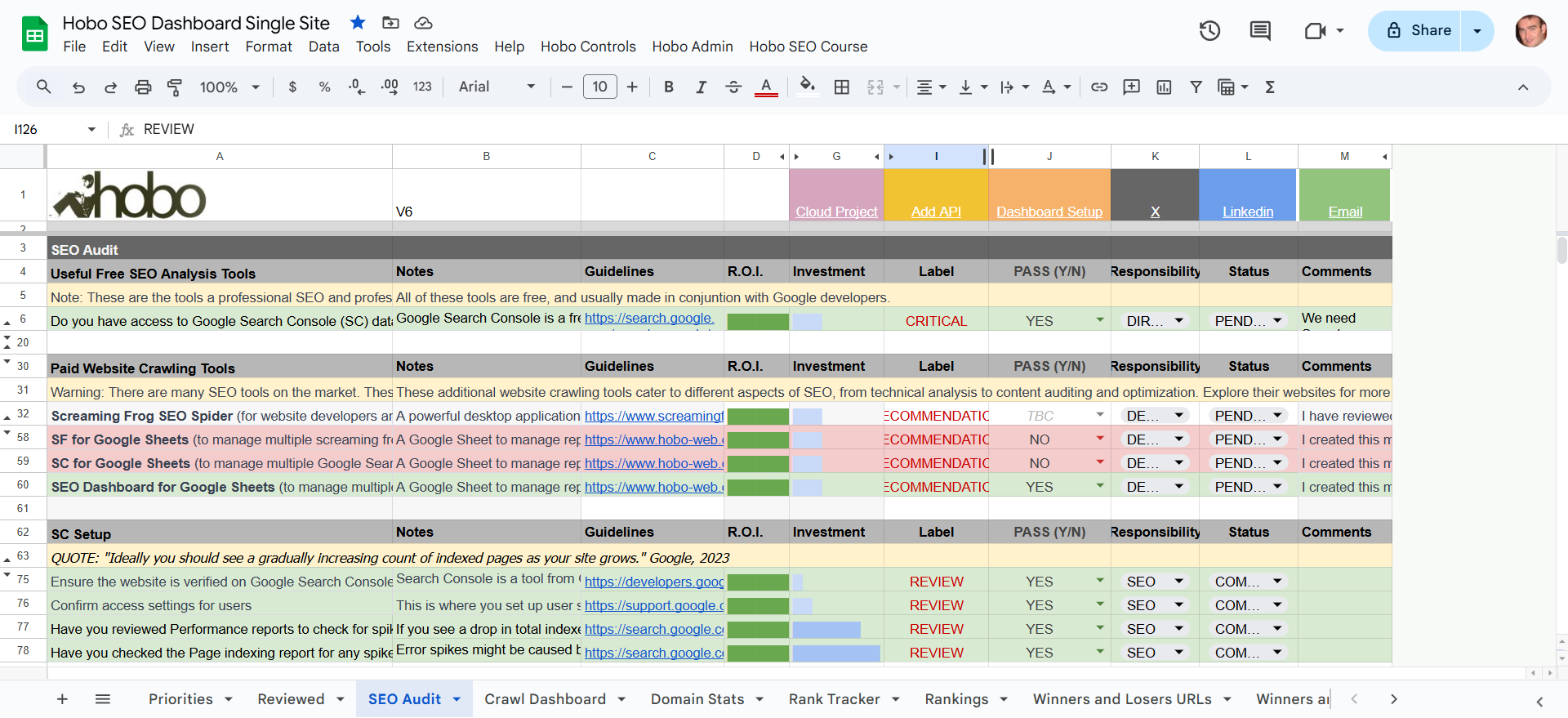
The backbone of every audit I perform is my set of proprietary checklists: the Hobo Premium SEO Checklist and the Hobo EEAT Checklist.
These are not static documents; they are living blueprints that are constantly updated to reflect the latest guidance from Google’s QRG and my own findings from analysing algorithm updates seriously since May 1 2010 – On May 1, 2010, Google released an algorithm update, often referred to as the “May Day” update, which primarily focused on long-tail keywords.
My checklists cover hundreds of points, from granular technical details to the high-level trust signals we’ve discussed.
They ensure that nothing is missed and provide what one customer called an “end-to-end blueprint” for aligning a site with Google’s guidelines.
Continuous Monitoring with the Hobo SEO Dashboard
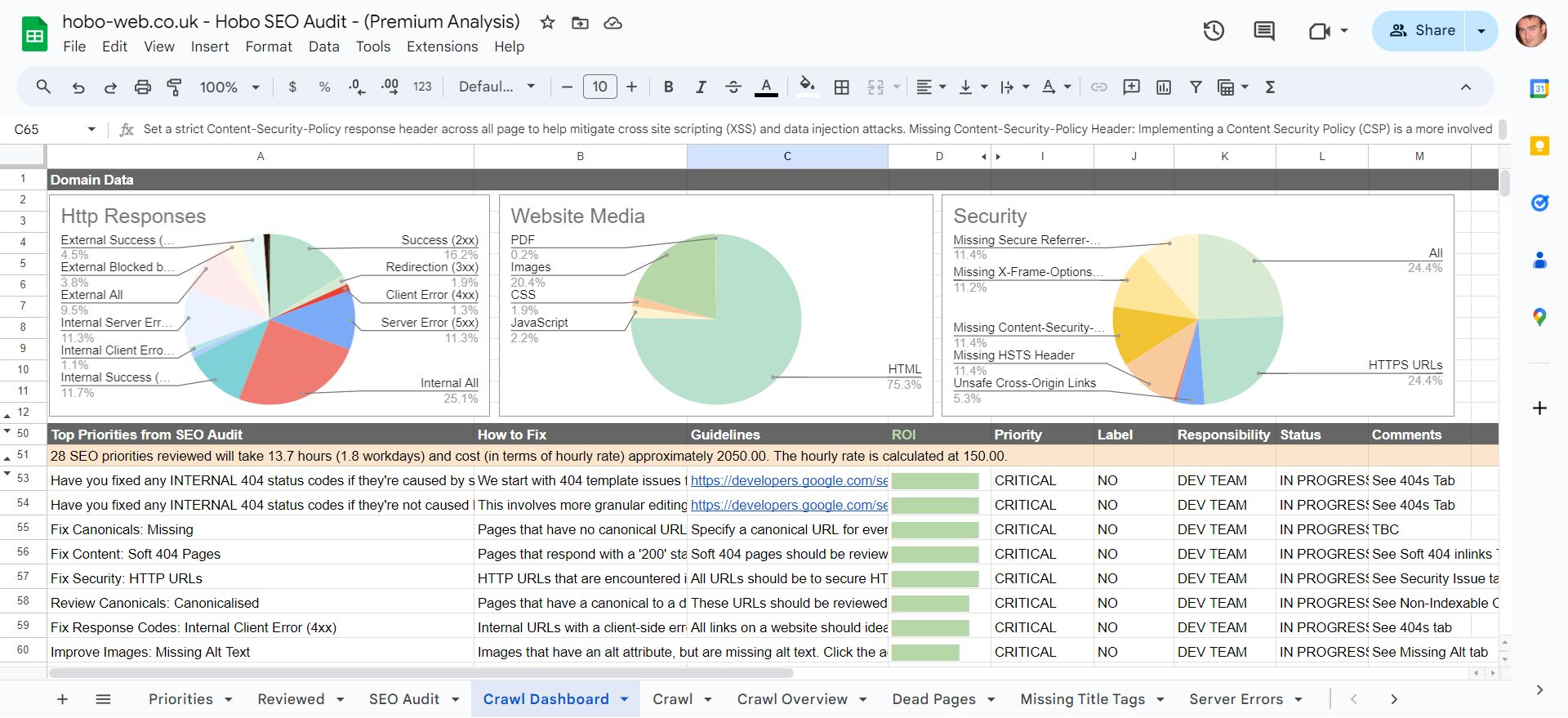
The Hobo SEO Dashboard is my command centre for ongoing technical health and performance analysis.
Built entirely within Google Sheets, it integrates directly with Google Search Console and Google Analytics to provide a live, automated view of your site’s vital signs.
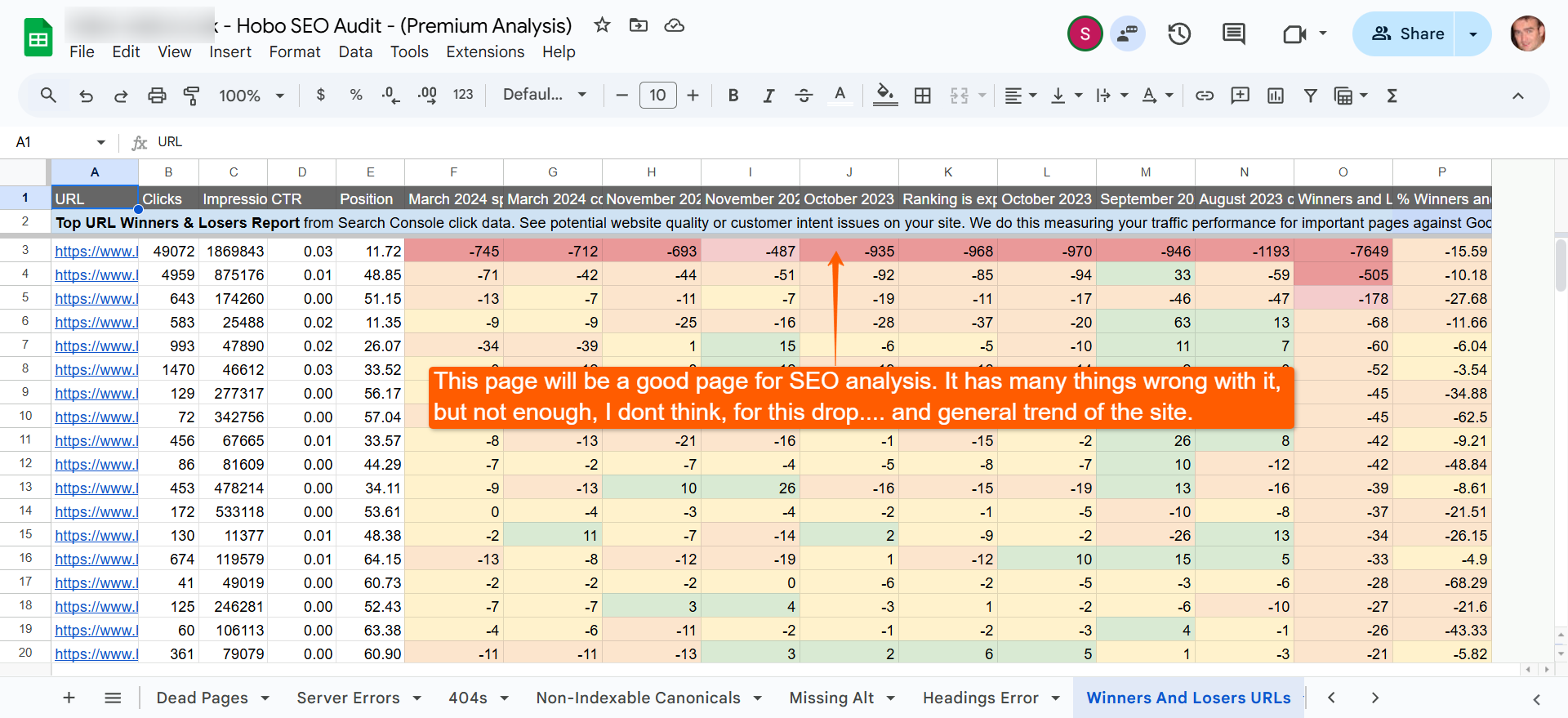
For an E-E-A-T audit, its key functions are:
- Technical SEO Prioritisation: The dashboard automates the analysis of website crawl data to immediately flag issues like broken links (404 errors) or server errors (500 errors). These are not just technical bugs; they are signals of a poorly maintained site, which directly erodes Trust.
- Algorithm Impact Analysis: The “Winners and Losers” reports are perhaps the most critical feature for navigating today’s environment. These reports automatically pull data from Search Console and compare your site’s performance—clicks, impressions, CTR, and position—in the periods before and after a major Google core update.25 This allows us to move beyond speculation and see precisely which pages and keywords were impacted, providing invaluable diagnostic data. It turns an abstract event like the one shown in Image 3 into a concrete list of problem areas.
- Automated Auditing: The system can be set to autonomously cycle through all your websites, run audits, and even email reports on a schedule you define. This ensures that technical health is monitored continuously, not just during a one-off audit.
Building Your Trust Foundation with the Hobo EEAT Tool
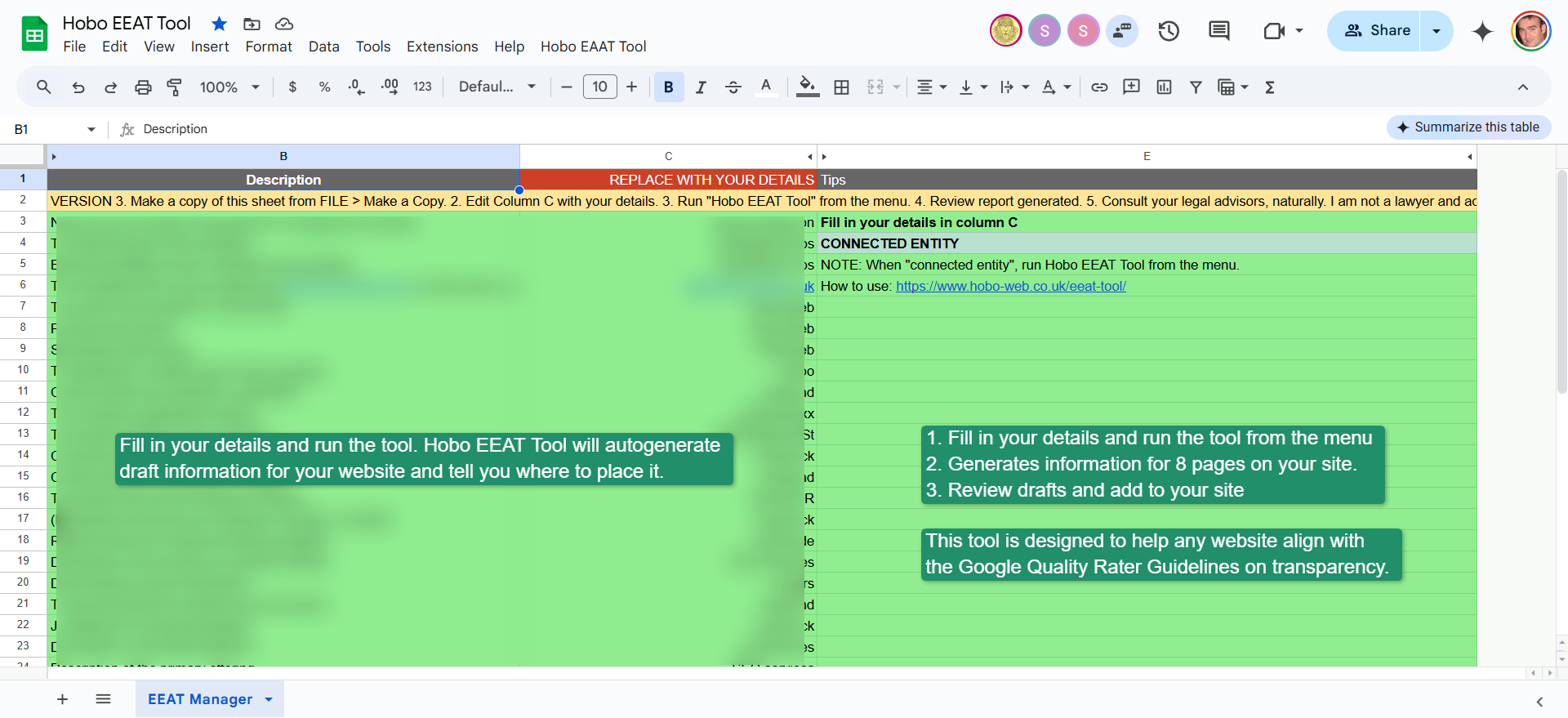
While the Dashboard handles continuous monitoring, the Hobo EEAT Tool is the specific solution designed to solve the “Disconnected Entity” problem at its root.
It provides a fast, systematic way to generate the foundational documents that prove to Google you are a legitimate, transparent, and accountable entity.
The process is straightforward and designed for efficiency, as shown in the screenshots below:
- Input Your Data: You begin by filling in your core business details—company name, address, contact info, etc.—into a simple Google Sheet.
- Generate Documents: You run the tool from the menu. It then takes your data and uses a predefined template to automatically generate a Google Doc containing drafts for up to eight essential trust-building pages: About Us, Contact Us, Privacy Policy, Terms of Service, and more.
- Implement with Guidance: The tool not only creates the draft content but also tells you where to place this information on your website to maximise its visibility to both users and search engines, ensuring you align with the QRG’s transparency guidelines.
The entire purpose of this tool is to address the QRG’s requirements for accountability head-on.
As I state on my website, “If your site is not a legitimate, transparent entity, it will not rank in Google, now and in the future”.21
The Hobo EEAT Tool is the most direct way to build that legitimacy and connect your entity to the real world.
The Strategic Roadmap: Building Topical Authority and Demonstrating Value
With the diagnostic work complete and the foundational trust signals in place, we can now move to the proactive, growth-oriented phase.
This is where we build on that trust to establish your website as an undeniable authority in its niche, creating a durable competitive advantage.
From Audit to Action: The Pillar-and-Cluster Model
The single most effective safe strategy for demonstrating Expertise and Authoritativeness at scale is to build real Topical Authority.
The goal is to make your website the definitive, go-to resource for a specific subject area, covering it so comprehensively that Google has no choice but to see you as the go-to website.
The most effective way to structure this is the pillar-and-cluster model (not a term I came up with).
- The Pillar Page: This is a single, substantial piece of content that provides a broad overview of your main topic. Think of it as a “Complete Guide to X”. It should touch upon all the major subtopics.
- The Cluster Pages: These are multiple, individual articles that each dive deep into one of the subtopics mentioned on the pillar page. For example, if your pillar is “Digital Marketing,” your clusters might be “SEO,” “PPC Advertising,” “Content Marketing,” and “Email Marketing”.
- The Linking Structure: This is key. The pillar page links out to every cluster page. Crucially, every cluster page links back to the central pillar page. You can also link relevant cluster pages to each other.
This model creates a dense, logically structured, and heavily internally-linked web of content.
For search engines, this structure makes it incredibly easy to crawl and understand the depth and breadth of your knowledge on a topic.
For users, it provides a clear, organised path to navigate your content, improving their experience and keeping them on your site longer.
I personally used this strategy to rank for “SEO” for many years and many other keywords (although it is too broad a topic for me to tackle at this time – maybe again in the future).
Creating Content That Serves the User, Not Just the Engine
As you build out your pillars and clusters, the quality of the content itself must align with the E-E-A-T principles we’ve covered.
- Focus on Information Gain: Don’t just write another article that says the same thing as the top 10 results. You must provide net new value. This concept, known as “information gain,” is about giving the user something they can’t get elsewhere. This could be original research, data from a survey you conducted, insights from your unique first-hand experience, or a case study with real results.
- Satisfy User Intent: Go beyond the keywords and ask what the user is truly trying to accomplish. If they search for “best running shoes,” they don’t just want a list; they want to know which shoe is best for them, for their foot type, running style, and budget. Your content must answer these implicit questions.
- Avoid “Unhelpful” Signals: Learn from the mistakes of sites that have been hit by updates. Case studies of recovery often show a clear pattern: successes came after removing intrusive ads, replacing generic stock photos with original images, and rewriting content to demonstrate real, first-hand experience.17
Remember the stark warning from the old Quality Rater Guidelines, which remains the guiding principle today:
“Important: Websites and pages which are created to …only make money with no attempt to help users should be rated LOWEST.” Google QRG 2014″.
Pages classed as lowest quality = spam to Google, and Google has terminator algorithms specifically looking to remove SPAM from Google’s search pages.
Your primary purpose must always be to help the user first.
Table 2: The E-E-A-T Action Plan
This table translates the entire E-E-A-T framework into a concrete, actionable checklist. This is your roadmap for systematic improvement.
| E-E-A-T Pillar | Actionable Tasks |
| Experience | Tip: Add a first-person perspective, incorporating a relevant personal anecdote or mini-case study. |
| Expertise | Tip: A Detailed author biography page for every person who writes content for your site. Include credentials, education, work history, and links to other publications. |
| Authoritativeness | Tip: Develop a digital PR strategy to earn high-quality links and mentions from authoritative, topically relevant publications. |
| Trust | Tip: Save hours and misconfigurations and run the Hobo EEAT Tool to generate comprehensive drafts for your About Us, Contact Us, Privacy Policy, and Terms of Service pages. Review, edit, finalise, and publish them. |
Conclusion: Your Ticket to the Party
In 2025 and beyond, building a trustworthy, verifiable online presence is not an optional SEO tactic; it is the fundamental price of admission. The days of ranking anonymous, low-effort websites on the back of clever tricks are definitively over. Google’s systems are now too sophisticated, and their goal is too clear.
The best way to summarise the current state of SEO is with this thought: “EEAT is like a ticket to the party. Without it, you are targeted by SPAM algorithm updates. Links and clicks do the actual ranking, I still think. The T in EEAT is the main lever”.
Trust gets you in the door. It proves you are a legitimate entity worthy of being considered. Once you are inside, the other elements—your Experience, Expertise, Authoritativeness, and the quality of your content and links—will determine how well you compete.
Your path forward is clear. Stop chasing fleeting algorithm changes. Stop looking for shortcuts. Start building a genuinely helpful, transparent, and authoritative resource for your users. Use the frameworks and tools outlined in this report to build your foundation of trust and demonstrate your expertise at scale.
That is the only sustainable path to long-term success in Google Search.
Value
This is arguably the most critical strategic investment a business can make in its online presence today.
Here’s exactly why.
Meeting EEAT is About Survival Before It’s About Growth
EEAT (Helpfulness) is a system designed by Google to reduce your visibility in Google Search if you do not have EEAT.
The first and most crucial value is risk mitigation. In the current digital landscape, ignoring E-E-A-T isn’t a neutral choice; it’s an active risk.
Google is no longer just promoting good sites; it is actively and aggressively demoting sites it deems untrustworthy or unhelpful.
Look at the traffic chart you saw earlier (Image 3). That volatility isn’t random; it’s the direct result of a site failing to meet Google’s core trust and quality thresholds during algorithm updates.
The March 2024 Core Update, for instance, was explicitly designed to reduce “low-quality, unoriginal content” by an estimated 40-45%.
An E-E-A-T audit is the diagnostic process to ensure your business is on the right side of that cleanup, not a casualty of it
It’s about preventing your analytics from ever looking like that chart.
2. It Provides a Clear, Actionable Roadmap in a Confusing Space
Most business owners are drowning in conflicting SEO advice.
The value of my service is that it cuts through the noise with a systematic, data-driven methodology based on Google’s own rulebooks – the Google Quality Rater Guidelines and Google’s extensive, continually evolving Webmaster Guidelines.
- The Hobo EEAT Tool: This isn’t a theoretical exercise. As you saw, the process starts with a simple Google Sheet where you input your business details. The tool then generates the essential policy and transparency documents that Google explicitly looks for to establish Trust. It directly solves the “Disconnected Entity” problem by creating tangible proof of who you are and why you’re accountable.
- The Hobo SEO Dashboard: This tool provides the ongoing monitoring needed to protect your investment. Its “Winners and Losers” reports analyse precisely how algorithm updates impact your pages, turning abstract news into a concrete to-do list.
- The Hobo SEO Checklists: The entire audit is underpinned by a comprehensive checklist that covers hundreds of points, from technical health to content quality, ensuring a thorough and repeatable process.
This combination moves a business from a state of confusion to one of clarity, with a prioritised list of actions that directly address the signals Google values.
3. It Builds a Long-Term Competitive Advantage
Businesses that proactively build their E-E-A-T aren’t just surviving updates; they are thriving because of them.
While your competitors who rely on shortcuts, thin content, or anonymity are being demoted, your site, fortified with genuine Experience, Expertise, Authoritativeness, and Trust, rises to fill the vacuum.
This service helps you build a “moat” around your digital presence. By establishing deep topical authority and demonstrating real-world expertise, you become the kind of reliable resource that is resilient to algorithmic shifts.
It’s a shift from a reactive strategy (panicking after an update) to a proactive one that builds a sustainable, long-term asset.
4. It Aligns Your Business with the Future of Search
Google’s direction is clear: it wants to reward real, accountable brands and creators, not anonymous web pages..
The emphasis on “Experience” is a direct countermeasure to the flood of generic AI content, prioritising authentic, first-hand knowledge.
This service is valuable because it fundamentally aligns your website with this long-term vision. It’s not about chasing the latest trick; it’s about building a genuine, trustworthy brand online that both your customers and Google can rely on. In the end, that trust is what drives not just rankings, but customer loyalty and revenue.
So, is this EEAT review useful for your business? Only if you consider survival, clarity, competitive advantage, and future-proofing your business to be valuable.
In my experience, serious businesses do.
Get a full EEAT based SEO audit for your website
Disclosure: Hobo Web uses generative AI when specifically writing about our own experiences, ideas, stories, concepts, tools, tool documentation or research. Our tool of choice is in this process is Google Gemini Pro 2.5 Deep Research. This assistance helps ensure our customers have clarity on everything we are involved with and what we stand for. It also ensures that when customers use Google Search to ask a question about Hobo Web software, the answer is always available to them, and it is as accurate and up-to-date as possible. All content was verified as correct. Edited and checked by Shaun Anderson, creator of Hobo SEO Dashboard, primary content creator at Hobo and founder of the Hobo Web site in 2006. See our AI policy.

